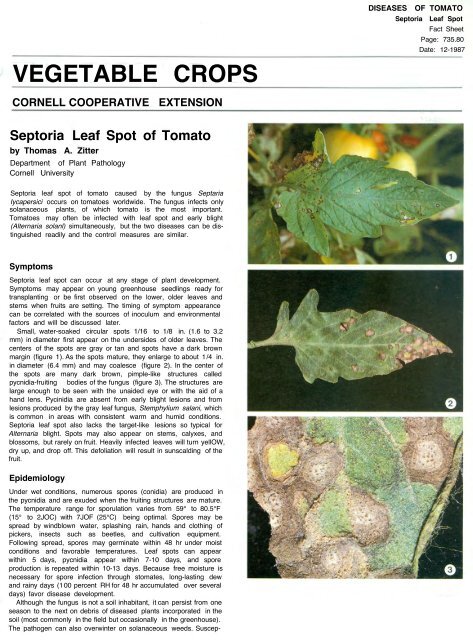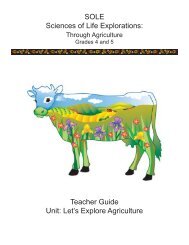315k pdf file - New York State Integrated Pest Management Program ...
315k pdf file - New York State Integrated Pest Management Program ...
315k pdf file - New York State Integrated Pest Management Program ...
You also want an ePaper? Increase the reach of your titles
YUMPU automatically turns print PDFs into web optimized ePapers that Google loves.
VEGETABLE CROPS<br />
CORNELL COOPERATIVE<br />
EXTENSION<br />
DISEASES OF TOMATO<br />
Septoria Leaf Spot<br />
Fact Sheet<br />
Page: 735.80<br />
Date: 12-1987<br />
Septoria Leaf Spot of Tomato<br />
by Thomas A. Zitter<br />
Department of Plant Pathology<br />
Cornell University<br />
Septoria leaf spot of tomato caused by the fungus Septaria<br />
Iycapersici occurs on tomatoes worldwide. The fungus infects only<br />
solanaceous plants, of which tomato is the most important.<br />
Tomatoes may often be infected with leaf spot and early blight<br />
(Alternaria solanl) simultaneously, but the two diseases can be distinguished<br />
readily and the control measures are similar.<br />
Symptoms<br />
Septoria leaf spot can occur at any stage of plant development.<br />
Symptoms may appear on young greenhouse seedlings ready for<br />
transplanting or be first observed on the lower, older leaves and<br />
stems when fruits are setting. The timing of symptom appearance<br />
can be correlated with the sources of inoculum and environmental<br />
factors and will be discussed later.<br />
Small, water-soaked circular spots 1/16 to 1/8 in. (1.6 to 3.2<br />
mm) in diameter first appear on the undersides of older leaves. The<br />
centers of the spots are gray or tan and spots have a dark brown<br />
margin (figure 1). As the spots mature, they enlarge to about 1/4 in.<br />
in diameter (6.4 mm) and may coalesce (figure 2). In the center of<br />
the spots are many dark brown, pimple-like structures called<br />
pycnidia-fruiting bodies of the fungus (figure 3). The structures are<br />
large enough to be seen with the unaided eye or with the aid of a<br />
hand lens. Pycinidia are absent from early blight lesions and from<br />
lesions produced by the gray leaf fungus, Stemphylium salani, which<br />
is common in areas with consistent warm and humid conditions.<br />
Septoria leaf spot also lacks the target-like lesions so typical for<br />
Alternaria blight. Spots may also appear on stems, calyxes, and<br />
blossoms, but rarely on fruit. Heavily infected leaves will turn yellOW,<br />
dry up, and drop off. This defoliation will result in sunscalding of the<br />
fruit.<br />
Epidemiology<br />
Under wet conditions, numerous spores (conidia) are produced in<br />
the pycnidia and are exuded when the fruiting structures are mature.<br />
The temperature range for sporulation varies from 59° to 80.5°F<br />
(15° to 2JOC) with 7JOF (25°C) being optimal. Spores may be<br />
spread by windblown water, splashing rain, hands and clothing of<br />
pickers, insects such as beetles, and cultivation equipment.<br />
Following spread, spores may germinate within 48 hr under moist<br />
conditions and favorable temperatures. Leaf spots can appear<br />
within 5 days, pycnidia appear within 7-10 days, and spore<br />
production is repeated within 10-13 days. Because free moisture is<br />
necessary for spore infection through stomates, long-lasting dew<br />
and rainy days (1 00 percent RH for 48 hr accumulated over several<br />
days) favor disease development.<br />
Although the fungus is not a soil inhabitant, it can persist from one<br />
season to the next on debris of diseased plants incorporated in the<br />
soil (most commonly in the field but occasionally in the greenhouse).<br />
The pathogen can also overwinter on solanaceous weeds. Suscep-
tible weeds include: jimsonweed (Datura stramonium), an annual<br />
reproducing by seed; horsenettle (Solanum carolinense), a perennial<br />
reproducing by seed and rhizomes; smooth groundcherry (Physalis<br />
subglabrata), a perennial reproducing by rhizomes and seed; and<br />
black nightshade (Solanum nigrum), an annual reproducing by<br />
seed. Crops infected are potato and eggplant in addition to tomato.<br />
Tomato seed has been shown to carry spores and produce<br />
infected seedlings, but whether the pathogen is truly seed borne is<br />
unknown.<br />
Control<br />
Cultural<br />
Eliminating initial sources of inoculum can greatly reduce the exent<br />
of disease.<br />
1. Because seed has been implicated as a source, make sure<br />
seed is acquired from disease-free seed-producing areas.<br />
2. Make sure greenhouse production areas are free of susceptible<br />
weeds and the previous season's tomato crop debris.<br />
Practice good sanitation. If infected plants are found, rogue the<br />
seedlings before transplanting them to the field.<br />
3. In the field, remove or destroy tomato debris by deep plowing<br />
immediately after harvest. A 1-year rotation out of tomato<br />
should be sufficient if no other sources of inoculum are<br />
available. Make sure perennial weed hosts such as horsenettle<br />
are eliminated before planting.<br />
4. Resistance to Septoria leaf spot has been identified in several<br />
plant introduction lines. Currently no commercial varieties are<br />
resistant.<br />
Fungicides<br />
Most fungicides registered for use on tomatoes would effectively<br />
control Septoria leaf spot. These include maneb, mancozeb, chlorothalonil,<br />
and benomyl. Captan is not effective and zineb may be<br />
difficult to purchase. Refer to the most recent issue of Cornell<br />
Vegetable Recommends for registered products and follow label<br />
directions. Fungicides are normally applied on a 7-10 day schedule<br />
unless disease pressure is high. The first sprays are usually needed<br />
when early blight control begins (early to mid-July) unless infected<br />
transplants were used, in which case sprays are required during wet<br />
periods in June.<br />
The photographic work of Kent Loeffler is acknowledged for figures 2 and 3.<br />
Every effort has been made to provide correct, complete, and up-to-date pesticide<br />
recommendations in this publication. Nevertheless, changes in pesticide regulations<br />
occur constantly, and human errors are still possible. These recommendations are not<br />
a substitute for pesticide labeling. Please read the label before applying any pesticide.<br />
Trade names used herein are for convenience only. No endorsement of products is<br />
intended and no criticism of unnamed products is implied.<br />
Cornell Cooperative Extension-Helping You Put Knowledge to Work<br />
Would you like our free catalog of extension publications? It is available from any county<br />
Cooperative Extension education center in <strong>New</strong> <strong>York</strong> <strong>State</strong>, or write to:<br />
Distribution Center<br />
7 Research Park<br />
Cornell University<br />
Ithaca. NY 14850<br />
Produced<br />
by Media Services at Cornell University<br />
This publication is issued to further Cooperative Extension work mandated by acts of<br />
Congress of May 8 and June 30,1914. It was produced with the cooperation of the U.S<br />
Department of Agriculture, Cornell Cooperative Extension, <strong>New</strong> <strong>York</strong> <strong>State</strong> College of<br />
Agriculture and Life Sciences, <strong>New</strong> <strong>York</strong> <strong>State</strong> College of Human Ecology, and <strong>New</strong><br />
<strong>York</strong> <strong>State</strong> College of Veterinary Medicine at Cornell University. Cornell Cooperative<br />
Extension offers equal program and employment opportunities. Lucinda A. Noble,<br />
Director.<br />
46/75 12/87 CP 3M 871237
















